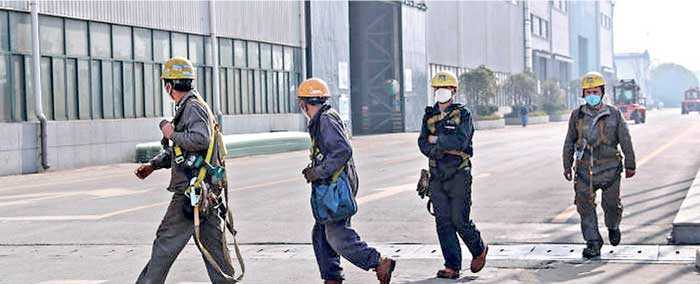Saturday Dec 13, 2025
Saturday Dec 13, 2025
Monday, 17 February 2020 00:27 - - {{hitsCtrl.values.hits}}

The effects of the deadly new coronavirus in China will be felt economically across the rest of the world - AFP
On 28 January 2020, the World Health Organization (WHO) declared the outbreak of the novel coronavirus (2019-nCoV) a global emergency. The new virus emerged in Wuhan, the capital of Hubei Province in China but has now spread to at least 27 other countries, including Sri Lanka.
At this stage, it is difficult to know the exact impact of the virus, but the human cost is significant. Chinese authorities have said the death toll in the country has exceeded 1,350 people, with the number of confirmed cases rising to almost 60,000 (as of 13 February), overtaking the Severe Acute Respiratory Syndrome (SARS) epidemic, which also originated in China and killed 774 people worldwide in 2003. Almost all of the fatalities have been in China so far, barring the cases reported in the Philippines and Hong Kong.
While the SARS virus had a limited effect on global growth of around 0.1% ($ 50-100 billion), the effect of the coronavirus epidemic is likely to vary, given its spread (faster), mortality rates (lower) and the measures taken to combat it (more and quicker response). 
So far, the outbreak has already disrupted economic activities in China and beyond; Wuhan and several other cities in China are under lockdown, travel is restricted and the Government has extended the annual Lunar New Year holiday to contain the spread of the disease. As a result, stock market prices have fallen, a large number of China’s factories and retail outlets remain temporarily closed with people encouraged to work from home, many international airlines have either stopped operating in or reduced flights to China and some countries such as Russia and Mongolia have closed their borders with China or denied entry (Australia, the US, Vietnam, etc.) to foreign nationals who have recently been in China. Global prices of commodities such as crude oil, copper, metals, etc. are down too.
Thus, it is safe to assume that the fallout from the coronavirus is going to be bigger than SARS, especially due to China’s economy being much bigger now and the world being more interconnected than in 2003. In 2019, the Chinese economy accounted for about 17% of global GDP, more than four times bigger than in 2003. The shutdowns of factories in China is having a major impact on the world’s second-largest economy and on global supply chains such as automobiles and electronics, for which China is an important supplier of intermediate manufactured goods or components.
Some big carmakers are already facing a shortage of parts. For instance, Hyundai, the world’s fifth-largest carmaker by sales had to shut down all its car factories in South Korea after running out of components coming from China, while other manufacturers like Fiat Chrysler warned that they too may have to suspend production in Europe. Electronics giant and a major supplier to Apple, Foxconn, has yet to reopen its largest factory in China. Currently, it is seeking permission from the Chinese Government to restart work at the closed plants. Finding alternative supplies will be particularly hard for products for which China is a dominant supplier. As such, while estimates of the 2019-nCoV outbreak’s economic impact vary greatly, some have estimated it to be high - at least around $ 360 billion.
Implications for Sri Lanka
Amid geopolitical tensions, prospects for the Chinese economy and global economic growth have weakened further with the outbreak of the coronavirus. Its effects will be felt most in the first quarter of 2020, depending on whether the virus can be contained.
Countries that are most dependent on China stand to be hit the hardest; these include countries in Asia and the Pacific, due to their economic relations with China. Sri Lanka is no exception, given its close links to China in terms of trade, investment and the movement of people over the past decade. According to a recent paper by the Overseas Development Institute (ODI) that measured which countries are susceptible to the impact of the coronavirus and the resulting slowdown in China’s economy, Sri Lanka was among the low and middle income countries that are most vulnerable to the situation.
Currently, China accounts for 3% of Sri Lanka’s total exports and 21% of its imports. While China is not an important export market compared to the US, India, Germany and the UK, a few products like precious metal ores, footwear and other base metals may be affected with a slump in demand in China, which accounts for more than 20% of these exports.
The effect on Sri Lanka would be greater on the imports side, since China is the second-largest source of goods to Sri Lanka after India. A wide range of imports, including machinery and appliances, fabrics, cotton, iron and steel, plastics, etc. are likely to be affected due to shipment delays as a result of factory closures and transport restrictions in China. Moreover, there are fears on the part of consumers about the safety of Chinese products and misconceptions about the virus being transmitted via contact with the products imported.
Sri Lanka also hosts a sizable number of temporary Chinese migrant workers, employed at various infrastructure projects in the country, such as the Port City. It has been reported that some of such constructions have temporarily stalled as Chinese workers remain in China following the outbreak or stay away from work for fear of discrimination
Concerningly, the tourism and the transport sectors in Sri Lanka, which were just recovering from the Easter terror attacks in April 2019, are already affected by the outbreak, with reports of a drop in tourist arrivals from China subsequent to restrictions placed by Sri Lanka and China on Chinese tourists. According to Sri Lanka Tourism Development Authority, arrivals of Chinese tourists were 6% lower during January 2020 in comparison to January last year. 
SriLankan Airlines, together with other Chinese airlines operating to Sri Lanka, have cut down on the frequencies of flights between Sri Lanka and China due to the slowdown in demand. China has emerged as an important source of tourists to Sri Lanka over the last decade and now make up over 10% of tourists to the country – the highest share after India. Sri Lanka’s withdrawal of visas on arrival to Chinese tourists and China’s ban on outbound group travel are going to affect the industry in the coming months.
Sri Lanka also hosts a sizable number of temporary Chinese migrant workers, employed at various infrastructure projects in the country, such as the Port City. It has been reported that some of such constructions have temporarily stalled as Chinese workers remain in China following the outbreak or stay away from work for fear of discrimination.
Countermeasures
So far, there has been only one confirmed case of infection in Sri Lanka - a tourist from China. Like other countries, Sri Lanka has undertaken measures to contain the spread of the virus, evacuating its citizens from China, quarantining all returnees from Wuhan, installing body temperature screening machines at the airports, placing restrictions on Chinese nationals visiting the country and setting up public hotlines to give information about the disease.
Amid growth fears, China has already pumped billions to control the virus and help areas and those affected, while a number of monetary measures are going to be introduced to provide liquidity and credit support to help affected companies and households. Other countries, including Sri Lanka, should be cognisant of the possible economic fallout of the virus, especially in the first quarter of 2020.
While many believe the impact on China’s economy and the rest of the world will be temporary, the economic damage will increase if the virus spreads and lasts for a prolonged period of time. According to the World Health Organization (WHO), currently, the epidemic can go in either direction.
(The writer is a Research Fellow at the Institute of Policy Studies of Sri Lanka. To talk to the author, email [email protected]. To view this article online and to share your comments, visit the IPS Blog ‘Talking Economics’ at http://www.ips.lk/talkingeconomics/)